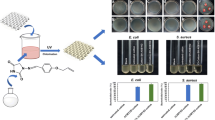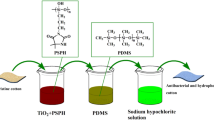Abstract
Cotton fabrics with durable antibacterial properties were prepared by a novel method of thiol-maleimide click reaction. Firstly, 3-Mercaptopropyltriethoxysilane was utilized as a modifier to generate thiol groups on the cotton surface. Then, these thiol groups reacted with N-phenyl-male-imide through thiol-maleimide click chemistry. The surface morphology of the treated fabrics and the reaction mechanism were characterized by FT-IR, Raman, EDS, XPS and SEM. Antibacterial activities, mechanical properties and thermal performance of treated cotton fabrics were also investigated. The Escherichia coli antibacterial rate of treated cotton was 99.56% and the Staphylococcus aureus antibacterial rate of treated cotton was 98.91%, with only a slight decrease after 10 cycles of standard washing, to 88.69 and 87.66%, respectively. These results demonstrated that this treatment effectively endowed cotton fabrics with durable antibacterial properties due to the chemical bonding formed between the antibacterial agent and the substrate. In addition, the treated cotton fabrics maintained good mechanical properties and thermal stability.
Graphical Abstract







Similar content being viewed by others
References
Baldwin AD, Kiick KL (2011) Tunable degradation of maleimide-thiol adducts in reducing environments. Bioconjugate Chem 22:1946–1953. https://doi.org/10.1021/bc200148v
Bashar MM, Khan MA (2013) An overview on surface modification of cotton fiber for apparel use. J Polym Environ 21:181–190
Belbekhouche S, Guerrouache M, Carbonnier B (2016) Thiol-maleimide michael addition click reaction: a new route to surface modification of porous polymeric monolith. Macromol Chem Phys 217:997–1006. https://doi.org/10.1002/macp.201500427
Billiet L, Gok O, Dove AP et al (2011) Metal-free functionalization of linear polyurethanes by thiol-maleimide coupling reactions. Macromolecules 44:7874–7878. https://doi.org/10.1021/ma201323g
Csw B, Al-Azzawi AM, Mahdi SAR et al (2013) Synthesis and evaluation of antimicrobial activity of several new maleimides to benzothiazole moiety. Baghdad Sci J 10:658–672
El Shafei A, Abou-Okeil A (2011) ZnO/carboxymethyl chitosan bionano-composite to impart antiacterial and UV protection for cotton fabric. Carbohydr Polym 83:920–925. https://doi.org/10.1016/j.carbpol.2010.08.083
Gargoubi S, Tolouei R, Chevallier P, Levesque L, Ladhari N, Boudokhane C, Mantovani D (2016) Enhancing the functionality of cotton fabric by physical and chemical pre-treatments: a comparative study. Carbohydr Polym 147:28
Gokmen MT, Brassinne J, Prasath RA, Du Prez FE (2011) Revealing the nature of thio-click reactions on the solid phase. Chem Commun (Camb) 47:4652–4654. https://doi.org/10.1039/c0cc05340f
Hassan MS, Ali HE, Ali NM (2017) Antibacterial activity of cotton fabrics treated with poly (vinyl alcohol)/ZnO nanocomposites, photocatalyzed by UV irradiation. J Vinyl Addit Technol 23:E34–E39. https://doi.org/10.1002/vnl.21593
He X, Tao R, Zhou T, Wang C, Xie K (2014) Structure and properties of cotton fabrics treated with functionalized dialdehyde chitosan. Carbohydr Polym 103:558–565
Huang Z et al (2017) Combining orthogonal chain-end deprotections and thiol-maleimide michael coupling: engineering discrete oligomers by an iterative growth strategy. Angew Chem Int Ed Engl 56:13612–13617. https://doi.org/10.1002/anie.201706522
Li J, He J, Huang Y (2016) Role of alginate in antibacterial finishing of textiles. Int J Biol Macromol 94:466–473
Li Y, Li W, Qian Z, Zhang L, Dong L, Wang L, Tang S (2017) Synthesis of N-phenylmaleimide/styrene/alpha methyl styrene/maleic anhydride tetrapolymers and its modification to ABS resin. Polym Mater Sci Eng 33:1–6. https://doi.org/10.16865/j.cnki.1000-7555.2017.06.001
Liu X, Xu Y (2014) Preparation process and antimicrobial properties of cross-linking chitosan onto periodate-oxidized bamboo pulp fabric. Fibers Polym 15:1887–1894
Navik R, Thirugnanasampanthan L, Venkatesan H, Kamruzzaman M, Shafiq F, Cai Y (2017) Synthesis and application of magnesium peroxide on cotton fabric for antibacterial properties. Cellulose 24:3573–3587. https://doi.org/10.1007/s10570-017-1356-0
Orhan M, Kut D, Gunesoglu C (2009) Improving the antibacterial activity of cotton fabrics finished with triclosan by the use of 1,2,3,4-butanetetracarboxylic acid and citric acid. J Appl Polym Sci 111:1344–1352. https://doi.org/10.1002/app.2508
Pounder RJ, Stanford MJ, Brooks P, Richards SP, Dove AP (2008) Metal free thiol-maleimide ‘Click’ reaction as a mild functionalisation strategy for degradable polymers. Chem Commun (Camb). https://doi.org/10.1039/b809167f
Ravi S, Krishnamurthy VR, Caves JM, Haller CA, Chaikof EL (2012) Maleimide-thiol coupling of a bioactive peptide to an elastin-like protein polymer. Acta Biomater 8:627–635. https://doi.org/10.1016/j.actbio.2011.10.027
Ravindra S, Murali Mohan Y, Narayana Reddy N, Mohana Raju K (2010) Fabrication of antibacterial cotton fibres loaded with silver nanoparticles via “Green Approach”. Colloids Surf A 367:31–40. https://doi.org/10.1016/j.colsurfa.2010.06.013
Salewska N, Boros-Majewska J, Lacka I, Chylinska K, Sabisz M, Milewski S, Milewska MJ (2012) Chemical reactivity and antimicrobial activity of N-substituted maleimides. J Enzyme Inhib Med Chem 27:117–124. https://doi.org/10.3109/14756366.2011.580455
Sanchez A, Pedroso E, Grandas A (2013) Oligonucleotide cyclization: the thiol-maleimide reaction revisited. Chem Commun (Camb) 49:309–311. https://doi.org/10.1039/c2cc35357a
Singh D, Chauhan NPS, Mozafari M, Hiran BL (2016) High-temperature resistive free radically synthesized chloro-substituted phenyl maleimide antimicrobial polymers. J Macromol Sci Part D—Rev Polym Process 55:1916–1939
Sun D, Wang W, Yu D (2016) Preparation of fluorine-free water repellent finishing via thiol-ene click reaction on cotton fabrics. Mater Lett 185:514–518
Travi M, Cremonesi L, Primignani P, Di BS, Testa R, Schilirò G, Ferrari M (2013) Antibacterial characteristics of electroless plating Ni–P–TiO2 coatings. Appl Surf Sci 274:101–104
Wang Y, Wang W, Liu B, Yu D (2017) Preparation of durable antibacterial and electrically conductive polyacrylonitrile fibers by copper sulfide coating. J Appl Polym Sci 134:45496. https://doi.org/10.1002/app.45496
Xi W, Scott TF, Kloxin CJ, Bowman CN (2014) Click Chemistry: click Chemistry in Materials Science. Adv Funct Mater 24:2566. https://doi.org/10.1002/adfm.201470113
Xu S et al (2016) Preparation and controlled coating of hydroxyl-modified silver nanoparticles on silk fibers through intermolecular interaction-induced self-assembly. Mater Des 95:107–118
Xu L, Wang W, Yu D (2017a) Durable flame retardant finishing of cotton fabrics with halogen-free organophosphonate by UV photoinitiated thiol-ene click chemistry. Carbohydr Polym 172:275–283
Xu L, Wang W, Yu D (2017b) Preparation of a reactive flame retardant and its finishing on cotton fabrics based on click chemistry. RSC Adv 7:2044–2050
Yu D, Xu L, Hu Y, Li Y, Wang W (2017) Durable antibacterial finishing of cotton fabric based on thiol–epoxy click chemistry. RSC Adv 7:18838–18843. https://doi.org/10.1039/c6ra28803k
Yue X, Lin H, Yan T, Zhang D, Lin H, Chen Y (2014) Synthesis of silver nanoparticles with sericin and functional finishing to cotton fabrics. Fibers Polym 15:716–722
Zhang F, Wu X, Chen Y, Lin H (2009) Application of silver nanoparticles to cotton fabric as an antibacterial textile finish. Fibers Polym 10:496–501. https://doi.org/10.1007/s12221-009-0496-8
Zhao C, Dong J, Li S, Fan Z (2012) Synthesis and characterization of heat-resistant N-phenylmaleimide-styrene-maleic anhydride copolymers and application in acrylonitrile–butadiene–styrene resin. J Appl Polym Sci 126:169–178
Acknowledgments
The research was supported by the Fundamental Research Funds for the Central Universities (No. 16D110518) and National Natural Science Foundation of China (No. 51403032).
Author information
Authors and Affiliations
Corresponding author
Rights and permissions
About this article
Cite this article
Fei, Z., Liu, B., Zhu, M. et al. Antibacterial finishing of cotton fabrics based on thiol-maleimide click chemistry. Cellulose 25, 3179–3188 (2018). https://doi.org/10.1007/s10570-018-1771-x
Received:
Accepted:
Published:
Issue Date:
DOI: https://doi.org/10.1007/s10570-018-1771-x




